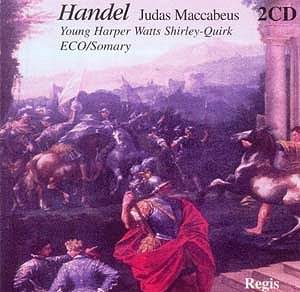Handel's oratorio Judas Maccabaeus is one of the composer's
most popular oratorios. The story follows Judas Maccabaeus, commander
of the Israelite army and orchestrator of the Maccabean revolt in the
second century B.C. After the death of the Israelite leader, Mattathias,
a new leader is needed, and Judas Maccabaeus answers the call. Judas
triumphs in battle, enemies build up against him and his people. The
third act follows the final triumph for Judas and his people, their
remembrance of those that have been lost while at the same time looking
forward to a future filled with peace and prosperity.
This recording was first released by Vanguard Classics
in 1971, and certainly shows its age. From the heavy vibrato-laden strings
to the dense choral movements, the tone of the time is present. Nevertheless,
in spite of the recent historically informed performance movement, this
work, like many of Somary’s recordings of the time, have no lack of
emotion. While the approach in this recording is certainly that of a
"classical" approach to Handel, there are many reasons why
it is still interesting. From the overall vision of the work to the
fine soloists, this recording has much to offer.
The four soloists are among the finest of their time,
and all give very good performances, though the first thing one notices
is the overuse of vibrato. John Shirley-Quirk is an excellent bass,
and he sings in the English tradition, giving a wonderful performance.
Tenor Alexander Young is also very good, though one can clearly hear
the age of this recording in his singing of Tis, well, my friends,
with his heavy voice over a tinkling harpsichord. But no matter, this
has almost a nostalgic sound, that of Handel as he was performed by
an earlier generation. Both of the female soloists are fine as well,
though it is a bit strange to hear the "Israelite woman and man"
singing a duet with both singers being women - though certainly no stranger
than hearing male countertenors sing female roles.
This oratorio has many choral movements, and, again,
the choir shows its age, but those who like this kind of punch choral
movements will be delighted. While this recording shows a few wrinkles
- after all, it is more than 30 years old - it has enough interest to
more than justify its bargain price.
Kirk McElhearn


